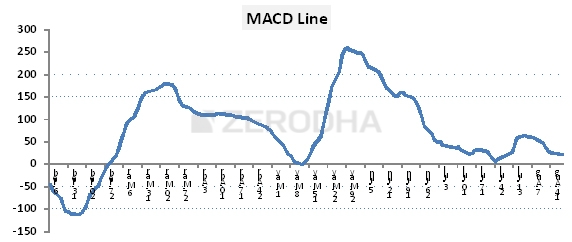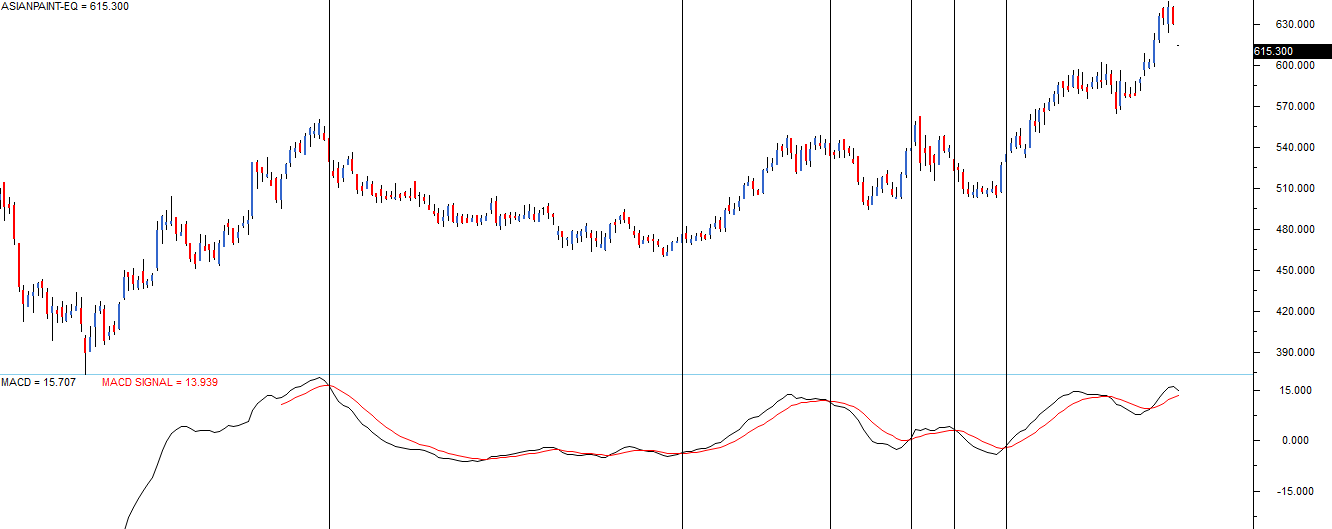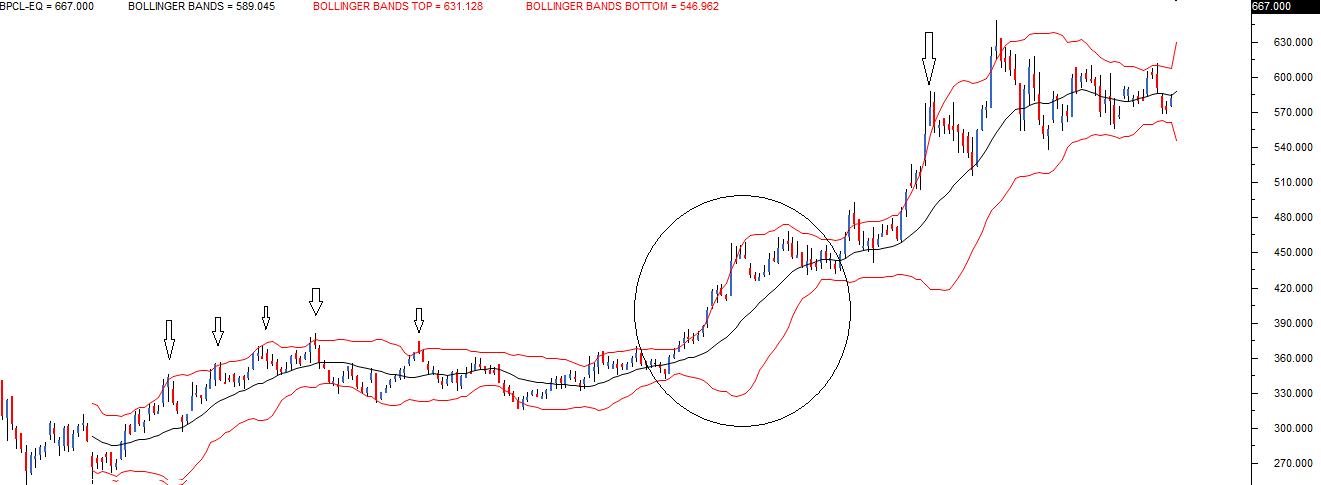How Do You Read a Macd Chart
xv.1 Moving Boilerplate Convergence and Departure (MACD)
In the late seventies, Gerald Appel developed the Moving Average Convergence and Divergence (MACD) indicator. Traders consider MACD every bit the one thousand one-time daddy of indicators. Though invented in the seventies, MACD is still considered one of the most reliable momentum traders' indicators.
As the name suggests, MACD is all nearly the convergence and divergence of the ii moving averages. Convergence occurs when the ii moving averages motion towards each other, and divergence occurs when the moving averages move away.
A standard MACD is calculated using a 12 day EMA and a 26 day EMA. Please note, both the EMA's are based on the endmost prices. Nosotros subtract the 26 EMA from the 12 day EMA, to approximate the convergence and divergence (CD) value. A elementary line graph of this is often referred to as the 'MACD Line'. Let us go through the math beginning and then figure out the applications of MACD.
| Date | Shut | 12 Twenty-four hour period EMA | 26 Mean solar day EMA | MACD Line |
|---|---|---|---|---|
| 1-Jan-14 | 6302 | |||
| 2-Jan-14 | 6221 | |||
| 3-Jan-14 | 6211 | |||
| 6-Jan-14 | 6191 | |||
| 7-Jan-14 | 6162 | |||
| 8-Jan-14 | 6175 | |||
| 9-Jan-14 | 6168 | |||
| 10-Jan-xiv | 6171 | |||
| xiii-Jan-14 | 6273 | |||
| xiv-Jan-xiv | 6242 | |||
| xv-Jan-xiv | 6321 | |||
| 16-Jan-14 | 6319 | |||
| 17-Jan-fourteen | 6262 | 6230 | ||
| 20-Jan-xiv | 6304 | 6226 | ||
| 21-Jan-14 | 6314 | 6233 | ||
| 22-Jan-14 | 6339 | 6242 | ||
| 23-Jan-14 | 6346 | 6254 | ||
| 24-Jan-fourteen | 6267 | 6269 | ||
| 27-Jan-fourteen | 6136 | 6277 | ||
| 28-Jan-fourteen | 6126 | 6274 | ||
| 29-Jan-fourteen | 6120 | 6271 | ||
| 30-Jan-fourteen | 6074 | 6258 | ||
| 31-Jan-14 | 6090 | 6244 | ||
| 3-Feb-14 | 6002 | 6225 | ||
| four-February-fourteen | 6001 | 6198 | ||
| 5-Feb-xiv | 6022 | 6176 | ||
| 6-Feb-14 | 6036 | 6153 | 6198 | -45 |
| seven-Feb-xiv | 6063 | 6130 | 6188 | -58 |
| 10-February-14 | 6053 | 6107 | 6182 | -75 |
| 11-Feb-fourteen | 6063 | 6083 | 6176 | -94 |
| 12-Feb-14 | 6084 | 6066 | 6171 | -106 |
| thirteen-Feb-14 | 6001 | 6061 | 6168 | -107 |
Allow usa become through the tabular array starting from left:
- We have the dates, starting from ist Jan 2014
- Side by side to the dates, we accept the closing price of Nifty
- We leave the outset 12 data points (closing toll of Nifty) to calculate the 12 day EMA
- We then leave the outset 26 data points to calculate the 26 day EMA
- Once we have both 12 and 26 day EMA running parallel to each other (6th February 2014) we calculate the MACD value
- MACD value = [12 day EMA – 26 day EMA]. For example, on 6th Feb 2014, 12 day EMA was 6153, and 26 mean solar day EMA was 6198. Hence the MACD would be 6153-6198 = – 45
When we summate the MACD value over 12 and 26 day EMAs and plot information technology as a line graph, we get the MACD line, which oscillates above and below the central line.
| Date | Shut | 12 Day EMA | 26 Day EMA | MACD Line |
|---|---|---|---|---|
| ane-January-14 | 6302 | |||
| 2-Jan-14 | 6221 | |||
| three-Jan-14 | 6211 | |||
| 6-Jan-fourteen | 6191 | |||
| 7-Jan-14 | 6162 | |||
| 8-January-14 | 6175 | |||
| nine-Jan-fourteen | 6168 | |||
| 10-January-14 | 6171 | |||
| 13-Jan-14 | 6273 | |||
| fourteen-Jan-fourteen | 6242 | |||
| xv-Jan-14 | 6321 | |||
| sixteen-Jan-xiv | 6319 | |||
| 17-Jan-fourteen | 6262 | 6230 | ||
| twenty-January-14 | 6304 | 6226 | ||
| 21-January-14 | 6314 | 6233 | ||
| 22-Jan-14 | 6339 | 6242 | ||
| 23-Jan-14 | 6346 | 6254 | ||
| 24-Jan-xiv | 6267 | 6269 | ||
| 27-Jan-14 | 6136 | 6277 | ||
| 28-Jan-14 | 6126 | 6274 | ||
| 29-Jan-14 | 6120 | 6271 | ||
| 30-Jan-fourteen | 6074 | 6258 | ||
| 31-Jan-xiv | 6090 | 6244 | ||
| 3-Feb-14 | 6002 | 6225 | ||
| 4-Feb-14 | 6001 | 6198 | ||
| 5-February-xiv | 6022 | 6176 | ||
| 6-Feb-14 | 6036 | 6153 | 6198 | -45 |
| 7-February-14 | 6063 | 6130 | 6188 | -58 |
| x-Feb-14 | 6053 | 6107 | 6182 | -75 |
| eleven-Feb-14 | 6063 | 6083 | 6176 | -94 |
| 12-Feb-fourteen | 6084 | 6066 | 6171 | -106 |
| 13-February-xiv | 6001 | 6061 | 6168 | -107 |
| 14-Feb-xiv | 6048 | 6051 | 6161 | -111 |
| 17-Feb-14 | 6073 | 6045 | 6157 | -112 |
| xviii-Feb-14 | 6127 | 6045 | 6153 | -108 |
| 19-Feb-14 | 6153 | 6048 | 6147 | -100 |
| twenty-February-14 | 6091 | 6060 | 6144 | -84 |
| 21-February-14 | 6155 | 6068 | 6135 | -67 |
| 24-Feb-xiv | 6186 | 6079 | 6129 | -fifty |
| 25-Feb-14 | 6200 | 6092 | 6126 | -34 |
| 26-Feb-xiv | 6239 | 6103 | 6122 | -19 |
| 28-Feb-14 | 6277 | 6118 | 6119 | -one |
| 3-Mar-xiv | 6221 | 6136 | 6117 | 20 |
| 4-Mar-14 | 6298 | 6148 | 6112 | 36 |
| 5-Mar-xiv | 6329 | 6172 | 6113 | 59 |
| half-dozen-Mar-14 | 6401 | 6196 | 6121 | 75 |
| vii-Mar-14 | 6527 | 6223 | 6131 | 92 |
| 10-Mar-14 | 6537 | 6256 | 6147 | 110 |
| xi-Mar-14 | 6512 | 6288 | 6165 | 124 |
| 12-Mar-xiv | 6517 | 6324 | 6181 | 143 |
| 13-Mar-14 | 6493 | 6354 | 6201 | 153 |
| fourteen-Mar-14 | 6504 | 6380 | 6220 | 160 |
Given the MACD value, permit's try and find the respond for a few obvious questions:
- What does a negative MACD value indicate?
- What does a positive MACD value signal?
- What does the magnitude of the MACD value really mean? As in, what data does a -90 MACD convey versus a – 30 MACD?
The sign associated with the MACD just indicates the direction of the stock's motion. For case, if the 12 Twenty-four hours EMA is 6380, and 26 Day EMA is 6220, the MACD value is +160. Under what circumstance exercise you lot think the 12 day EMA will be greater than the 26 day EMA? Well, we had looked into this in the moving boilerplate chapter. The shorter-term average will mostly exist college than the long term just when the stock price trends upward. Think, the shorter-term average will always be more than reactive to the current market price than the long term boilerplate. A positive sign tells us that in that location is positive momentum in the stock, and the stock is drifting upwardly. The college the momentum, the higher is the magnitude. For example, +160 indicate a positive tendency which is stronger than +120.
All the same, while dealing with the magnitude, e'er remember the price of the stock influences the magnitude. For example, the higher the underlying price such as Bank Peachy, naturally, the higher will be the magnitude of the MACD.
When the MACD is negative, it means the 12 day EMA is lower than the 26 day EMA. Therefore the momentum is negative. College the magnitude of the MACD, the more strength in the down trend.
The departure betwixt the two moving averages is called the MACD spread. The spread decreases when the momentum mellows downward and increases when the momentum increases. To visualize convergence and the departure traders usually plot the MACD value nautical chart, often referred to as the MACD line.
The following is the MACD line chart of Cracking for data points starting from 1st Jan 2014 to 18th Aug 2014.

Equally you tin see, the MACD line oscillates over a central null line. This is besides called the 'Centerline'. The basic estimation of the MACD indicator is:
- When the MACD Line crosses the centerline from the negative territory to positive territory, it means there is a divergence between the ii averages. This is a sign of increasing bullish momentum; therefore, one should look at buying opportunities. From the nautical chart above, we can see this panning out around 27thursday Feb
- When the MACD line crosses the centerline from positive territory to the negative territory, it means there is a convergence betwixt the ii averages. This is a sign of increasing bearish momentum; therefore, one should look at selling opportunities. As you can run into, in that location were two instances during which the MACD virtually turned negative (8th May, and 24th July) but the MACD just stopped at the zero lines and reversed directions.
Traders generally argue that while waiting for the MACD line to crossover the centerline, a majority of the moving-picture show would already exist done and perhaps it would exist late to enter a merchandise. To overcome this, there is an improvisation over this bones MACD line. The improvisation comes in the form of an additional MACD component which is the 9-twenty-four hour period signal line. A 9-day signal line is an exponential moving boilerplate (EMA) of the MACD line. If you think about this, we now have 2 lines:
- A MACD line
- A nine mean solar day EMA of the MACD line as well called the betoken line.
A trader can follow a simple two line crossover strategy with these 2 lines as discussed in the moving averages chapter and no longer wait for the centerline cross over.
- The sentiment is bullish when the MACD line crosses the 9 day EMA wherein MACD line is greater than the 9 days EMA. When this happens, the trader should look at buying opportunities.
- The sentiment is bearish when the MACD line crosses beneath the 9 day EMA wherein the MACD line is bottom than the 9 day EMA. When this happens, the trader should look at selling opportunities.
The chart below plots the MACD indicator on Asian Paints Express. Y'all can meet the MACD indicator below the price chart.

The indicator uses standard parameters of MACD:
- 12 mean solar day EMA of endmost prices
- 26 twenty-four hours EMA of endmost prices
- MACD line (12D EMA – 26D EMA) represented by the black line
- 9 twenty-four hour period EMA of the MACD line represented by the red line
The chart's vertical lines highlight the chart's crossover points where a bespeak to buy or sell originated.
For example, the first vertical line starting from left points to a crossover where the MACD line lies beneath the betoken line (9 twenty-four hours EMA) lies and suggests a curt trade.
The 2nd vertical line from left points to a crossover where the MACD line lies above the signal line should look at buying opportunity. And then on and and then forth.
Delight note, at the core of the MACD system, are moving averages. Hence the MACD indicator has like properties like that of a moving average system. They work quite well when at that place is a strong trend and are not too useful when moving sideways. Y'all can detect this between the 1st ii-line starting from left.
Needless to say, the MACD parameters are non set in stone. One is free to change the 12 days, and 26 day EMA to whatsoever time frame one prefers. I personally similar to apply the MACD in its original grade, as introduced past Gerald Appel.
15.2 – The Bollinger Bands
Introduced past John Bollinger in the 1980s, Bollinger Bands (BB) is perhaps 1 of the most useful technical analysis indicators. BB is used to determine overbought and oversold levels, where a trader will try to sell when the price reaches the meridian of the band and will execute a buy when the price reaches the bottom of the band.
The BB has 3 components:
- The middle line which is The 20 day simple moving average of the endmost prices
- An upper band – this is the +2 standard deviation of the middle line
- A lower band – this is the -two standard deviation of the heart line
The standard deviation (SD) is a statistical concept; which measures a item variable'southward variance from its average. In finance, the standard deviation of the stock toll represents the volatility of a stock. For example, if the standard deviation is 12%, it is as practiced equally proverb that the stock'south volatility is 12%.
In BB, the standard difference is applied on the twenty days SMA. The upper ring indicates the +two SD. Using a +2 SD, we multiply the SD by 2 and add together it to the average.
For example if the 20 twenty-four hour period SMA is 7800, and the SD is 75 (or 0.96%), then the +ii SD would be 7800 + (75*ii) = 7950. Likewise, a -2 SD indicates we multiply the SD by ii and decrease it from the average. 7800 – (ii*75) = 7650.
We now have the components of the BB:
- 20 day SMA = 7800
- Upper band = 7950
- Lower band = 7650
Statistically speaking, the current market place price should hover effectually the boilerplate toll of 7800. Nonetheless, if the current market price is effectually 7950, it is considered expensive concerning the average. Hence one should look at shorting opportunities with an expectation that the price will scale dorsum to its average cost.
Therefore the trade would be to sell at 7950, with a target of 7800.
Likewise, if the electric current market cost is around 7650, it is considered cheap concerning the average prices. Hence, one should consider buying opportunities to expect that the prices volition scale back to its average cost.
Therefore the trade would be to purchase at 7650, with a target of 7800.
The upper and lower bands human activity as a trigger to initiate a trade.
The following is the nautical chart of BPCL Limited,

The central blackness line is the xx solar day SMA. The ii ruby-red lines placed above and beneath the black like are the +2 SD and -2SD. The thought is to curt the stock when the toll touches the upper band, expecting it to revert to average. Also, one can go long when the cost touches the lower band, expecting it to revert to the boilerplate.
I accept highlighted using a downward pointer all the sell signals BB generated, while virtually of the signals worked quite well, there was a stage when the price stuck to the upper band. In fact, the cost continued to drift higher, and therefore even the upper band expanded. This is called an envelope expansion.
The BB's upper and lower ring together forms an envelope. The envelope expands, whenever the price drifts in a detail direction, indicating strong momentum. The BB signal fails when there is an envelope expansion. This leads us to an of import decision; BB works well in sideways markets and fails in a trending market.
Whenever I use BB, I wait the merchandise to start working in my favour almost immediately. If it does not, I start validating the possibility of an envelope expansion.
15.iii – Other Indicators
There are numerous other technical indicators, and the list is endless. The question is, should y'all know all these indicators to be a successful trader? The reply is a unproblematic no. Technical indicators are practiced to know, but they by no means should be your main tool of analysis.
I take personally met many aspiring traders who spend a lot of time and energy learning unlike indicators, but this is futile in the long run. The working knowledge of a few basic indicators, such as those discussed in this module is sufficient.
xv.4 – The Checklist
In the previous chapters, we started building a checklist that acts as a guiding forcefulness behind the trader's decision to buy or sell. It is time to revisit that checklist.
The indicators act equally a tool which the traders can use to confirm their trading decisions, and it is worthwhile to check what the indicators are conveying before placing a buy or a sell order. While the dependence on indicators is non as much S&R, volumes or candlestick patterns, information technology is always good to know what the basic indicators suggest. For this reason, I would recommend adding indicators in the checklist, but with a twist to it. I will explain the twist in a chip, but before that, let us reproduce the updated checklist.
- The stock should form a recognizable candlestick pattern
- S&R should confirm to the merchandise. The stoploss toll should be around Southward&R
- For a long trade, the low of the design should be around the support
- For a short trade, the high of the pattern should exist around the resistance
- Volumes should confirm
- Ensure above average volumes on both buy and sell 24-hour interval
- Low volumes are not encouraging, hence do feel gratis to hesitate while taking trade where the volumes are depression
- Indicators should confirm
- Calibration the size higher if the confirm
- If they don't confirm, go ahead with the original program
The sub-bullet points under indicators are where the twist lies.
Now, hypothetically imagine a situation where yous are looking at an opportunity to buy shares of Karnataka Bank Limited. On a particular solar day, Karnataka Bank has formed a bullish hammer, presume everything ticks on the checklist:
- Bullish hammer is a recognizable candlestick pattern
- The low of the bullish hammer also coincides with the support
- The volumes are to a higher place boilerplate
- There is also a MACD crossover (signal line turns greater than the MACD line)
With all four checklist points beingness ticked off I would be happy to buy Karnataka Bank. Hence I place an order to buy, allow usa say for 500 shares.
However, imagine a situation where the first iii checklist conditions are met, only the fourthursday condition (indicators should ostend) is not satisfied. What do you lot recollect I should do?
I would still go ahead and buy, but instead of 500 shares, I'd probably buy 300 shares.
This should hopefully convey to you how I tend to (and advocate) the utilize of indicators.
When Indicators ostend, I increase my bet size, but when Indicators don't confirm I still go ahead with my conclusion to purchase, I scale down my bet size.
However, I would not practice this with the offset three checklist points. For example, if the low of the bullish hammer does non coincide in and effectually the support, I'll really reconsider my plan to purchase the stock; in fact, I may skip the opportunity, and wait for another opportunity.
Only I do not care for the indicators with the same conviction. Information technology is always good to know what indicators convey, but I don't base of operations my decisions. If the indicators confirm, I increment the bet size; if they don't, I still get ahead with my original game plan.
Key takeaways from this chapter
- A MACD is a trend following system
- MACD consists of a 12 24-hour interval, 26 solar day EMA
- MACD line is 12d EMA – 26d EMA
- The signal line is the ix day SMA of the MACD line
- A crossover strategy can exist practical betwixt the MACD Line and the indicate line
- The Bollinger band captures the volatility. It has a twenty-day average, a +2 SD, and a -2 SD
- One can short when the current price is at +2SD with an expectation that the price reverts to the average
- One can go long when the current price is at -2SD with an expectation that the cost reverts to the boilerplate
- BB works well in a sideways market. In a trending market, the BB's envelope expands and generates many simulated signals
- Indicators are practiced to know, but it should not be treated as a single source for decision making.
Source: https://zerodha.com/varsity/chapter/indicators-part-2/

0 Response to "How Do You Read a Macd Chart"
Post a Comment